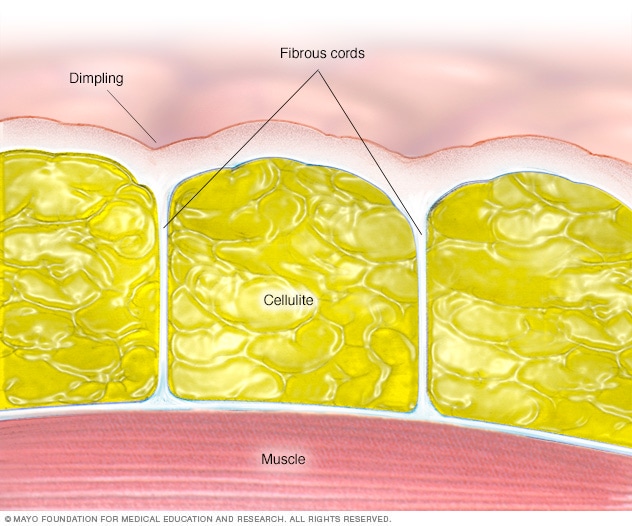Cellulitis
Cellulitis
overview
Anatomy of cellulite

Anatomy of cellulite
As fat cells increase, they press against the skin. Robust, long connecting cords pull downwards. This creates an uneven surface or dimpling, often referred to as cellulite.
Cellulite is a very common, harmless skin condition that causes lumpy, dimpling flesh on the thighs, hips, buttocks, and stomach. The condition most commonly occurs in women.
Many people try, with varying degrees of success, to improve the appearance of their skin through weight loss, exercise, massage, and creams marketed as cellulite solutions. Medically proven treatment options are also available, although results are not immediate or long-lasting.
Symptoms
Cellulite looks like dimples or bumpy skin. It is sometimes described as having a texture of cottage cheese or orange peel.
You can only see mild cellulite if you pinch your skin in an area where you have cellulite, such as: B. on your thighs. More severe cellulite makes the skin appear wrinkled and bumpy, with areas of peaks and valleys.
Cellulite most commonly appears on the thighs and buttocks, but can also be found on the breasts, lower abdomen, and upper arms.
When to go to the doctor?
No treatment is required. However, if you are concerned about the appearance of your skin, speak to your primary care doctor or a skin disease specialist (dermatologist) or plastic surgery specialist about treatment options.
Causes
Little is known about the causes of cellulite. They are fibrous connective cords that connect the skin to the underlying muscle, with fat in between. As fat cells accumulate, they push against the skin as the long, hard strands pull downward. This creates an uneven surface or depression.
In addition, hormonal factors play a large role in the development of cellulite, and genetics determine skin structure, texture and body type. Other factors such as weight and muscle tone affect whether you have cellulite, although very fit people can also be affected.
Risk factors
Cellulite is much more common in women than in men. In fact, most women develop cellulite after puberty. This is because women's fat is typically distributed in the thighs, hips and buttocks - common areas for cellulite. Cellulite is also more common with age as the skin loses elasticity.
Weight gain can make cellulite more noticeable, but some slim people also have cellulite. It tends to run in families, so genetics could play the biggest role in whether you develop cellulite. An inactive lifestyle can also increase your chances of developing cellulite, as can pregnancy.
Sources:
- Khan MH, et al. Behandlung von Cellulite: Teil I. Pathophysiologie. Zeitschrift der American Academy of Dermatology. 2010; doi:10.1016/j.jaad.2009.10.042. Abgerufen am 13. September 2019.
- Khan MH, et al. Behandlung von Cellulite: Teil II. Fortschritte und Kontroversen. Zeitschrift der American Academy of Dermatology. 2010; doi:10.1016/j.jaad.2009.10.041. Abgerufen am 13. September 2019.
- Neue und verbesserte Laser- und Lichtbehandlungen zielen auf Cellulite, Fett, Tätowierungen, Falten und schlaffe Haut ab. Amerikanische Akademie für Dermatologie. https://www.aad.org/media/news-releases/new-and-improved-laser-and-light-treatments-take-aim-at-cellulite-fat-tattoos-folds-and-sagging-skin. Abgerufen am 13. September 2019.
- DiBernardo BE, et al. Oberflächenlaser und Radiofrequenz zur Gesichts- und Körperverjüngung. Kliniken für Plastische Chirurgie. 2016; doi:10.1016/j.cps.2016.03.009. Abgerufen am 13. September 2019.
- Cellulite-Behandlungen: Was wirklich hilft. Amerikanische Akademie für Dermatologie. https://www.aad.org/public/diseases/cosmetic-treatments/cellulite-treatments. Abgerufen am 12. September 2019.
- Übel CO, et al. Cellulite: Ein chirurgischer Behandlungsansatz. Zeitschrift für Ästhetische Chirurgie 2018; doi:10.1093/asj/sjy028. Abgerufen am 11. September 2019.
- Fowler GC, et al., Hrsg. Cellulite-Behandlungen. In: Pfenninger und Fowler’s Procedures for Primary Care. 4. Aufl. Elsevier; 2020. https://www.clinicalkey.com. Abgerufen am 12. September 2019.
- Bolognia JL, et al., Hrsg. Körperkonturierung: Fettabsaugung und nicht-invasive Modalitäten. In: Dermatologie. 4. Aufl. Saunders Elsevier; 2018. https://www.clinicalkey.com. Abgerufen am 12. September 2019.
- Callaghan DJ, et al. Updates in der Cellulite-Reduktion. Fortschritte in der kosmetischen Chirurgie. 2018; doi:10.1016/j.yacs.2018.02.006.
- Gibson LE (Gutachten). Mayo-Klinik. 13. November 2019.

 Suche
Suche
 Mein Konto
Mein Konto